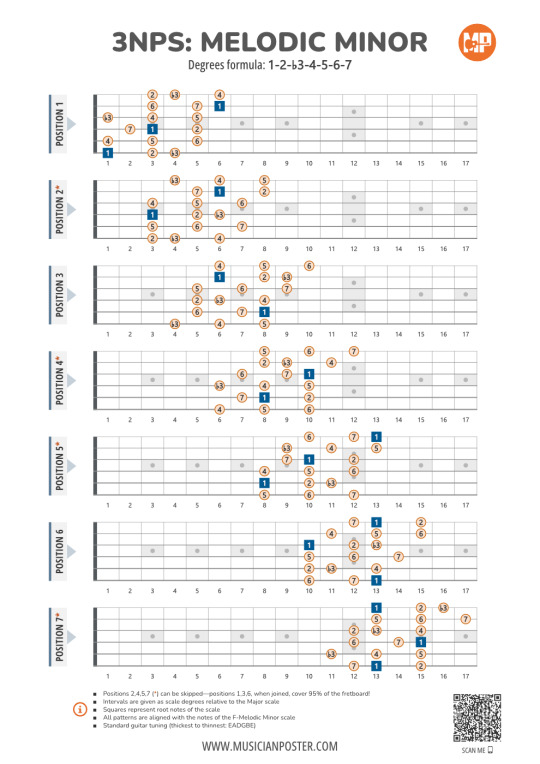#GuitarPractice
Explore tagged Tumblr posts
Text

Struggling to Navigate the Fretboard?
Stop feeling lost every time you play. Fret Logic is a simple, 4-week guide to mastering the fretboard. Whether you’re learning scales, chords, or improvisation, this guide will show you how to connect it all.
The best part? You can get it for FREE.
Join my Discord to grab your copy
#FretboardMastery#GuitarTips#GuitarPractice#learn guitar#guitar lessons#GuitaristTools#discord server#BeginnerGuitar#MasterTheFretboard#GuitarScales#FreeEbook#FreeGuitarTips#GuitaristCommunity#GuitaristsOfTumblr#GuitarChallenge#DownloadNow#GuitarGuide#GuitarTheory#GuitarFretboard#GuitarEducation
2 notes
·
View notes
Text
3NPS Melodic Minor Patterns for Shredding
I've just released the last of the common Minor scales for the 3NPS system: the Melodic Minor scale patterns.
The chart is already available in all 3 common variations that I usually produce: ■ with beginner-friendly note names ■ as scale degrees ■ and as flat style notes for those who like it clean!


Download them all here (variations are linked down at the bottom):
And we're getting closer to finishing the 3NPS for shredding series. Still a couple of scales left in the family of Melodic Minor and one scale from the Double Harmonic Major scale.
Hope you have fun with it!
If you find this content helpful, I'd appreciate any kind of support—a Like, a share, or a comment—everything helps! Have fun learning! Oleg
#guitarplayers#guitarlesson#guitarpractice#musicman#instamusic#singers#musictheory#musicproducer#acousticguitarcover#musicianposter#musicposter
2 notes
·
View notes
Text
How to Play Scales for Lead Guitar – A Beginner-to-Pro Journey

1. Why Scales Are Crucial for Lead Guitar 2. Understanding the Language of MusicWhat is a Scale? Most Used in Lead Guitar: 3. Top 3 Scales Every Lead Guitarist Must LearnA Minor Pentatonic (Box 1) C Major Scale (CAGED Friendly Shape) E Blues Scale 4. CAGED System – Unlock the Fretboard 5. 30-Min Daily Practice Routine 6. How to Improvise Using Scales🎯 Start Simple 🎯 Add Flavor 7. Common Mistakes to Avoid 8. What’s Next? Explore Modes, Fusion, Ragas 9. Helpful Strummuse Resources Conclusion
1. Why Scales Are Crucial for Lead Guitar
If chords are the foundation of a song, then scales are its soul. Whether you're crafting solos, improvising on stage, or jamming with friends, your lead guitar journey starts with mastering scales. When you learn scales: - You stop “guessing” notes - Your fingers move with purpose - You sound musical—not mechanical Lead legends like Slash, Satriani, or Indian icons like Ehsaan Noorani? They didn’t start with licks, they started with scales.
2. Understanding the Language of Music
Before we shred, let’s simplify some theory. What is a Scale? A scale is just a sequence of notes in a particular order, usually within an octave. Think of it like a color palette from which melodies are painted. Most Used in Lead Guitar: Scale NameMoodExample UseMajor ScaleHappy / BrightPop, Bollywood introsMinor ScaleEmotional / MelancholyRomantic leadsPentatonicRaw / GroovyRock, Blues, FolkBlues ScaleGritty / SoulfulClassic solos
3. Top 3 Scales Every Lead Guitarist Must Learn
Let’s go hands-on now. Here are the essential scale patterns you should memorize first. A Minor Pentatonic (Box 1) The #1 lead scale. Used in 90% of beginner guitar solos. e|-----------------5--8-- B|-------------5--8----- G|---------5--7---------- D|-----5--7-------------- A|-5--7------------------ E|-5--8------------------ ✅ Use this over Am, C, G chord progressions. 🎧 Try it over: - “Tera Ban Jaunga” (Capo on 1st fret – See chords) - “Tum Mile” unplugged version C Major Scale (CAGED Friendly Shape) e|------------------7-8-- B|--------------8-10----- G|--------7-9-10---------- D|--7-10------------------ A|--8-10------------------ E|--7-8------------------- This pattern gives you bright, melodic soloing options. Learn it in all positions. 🎧 Try it over: - “O Sajni Re” - “Tum Hi Ho” intro solo E Blues Scale e|-----------------12-15-- B|-------------12-15----- G|--------12-14-15-------- D|-----12-14-------------- A|-12-13-14--------------- E|-12-15------------------ Add bluesy tension—great for solos with attitude.
4. CAGED System – Unlock the Fretboard
The CAGED system teaches you to move scales across the neck using 5 chord shapes: C – A – G – E – D Each shape = scale pattern. Example: - E minor scale using E shape → move to 5th fret → you’re in A minor - Link patterns to go from soloing in one box to full neck freedom Want a visual breakdown? Check Here
5. 30-Min Daily Practice Routine
TimeTask5 minWarm up: Basic alternate picking10 minPlay 2 scale boxes (slow to fast)5 minConnect root notes across patterns5 minPractice bends, hammer-ons in scale5 minJam to a backing track in A minor 🎯 Pro tip: Record yourself weekly — you’ll hear the progress you can’t see. Helpful Links :- - How To Practice Guitar at Home Daily - Guitar Finger Practice Techniques for Beginners
6. How to Improvise Using Scales
Learning scales isn’t enough—you’ve got to make music with them. 🎯 Start Simple - Use only 3 notes from a scale - End phrases on root or chord tone - Repeat licks — don’t overplay 🎯 Add Flavor - Bends & slides make solos expressive - Leave space between notes - Use dynamics (soft, loud, pause, etc.) 🎧 Example Practice Backing Tracks: - “Sad Bollywood Beat in Am” – - “Happy Progression in G” –
7. Common Mistakes to Avoid
MistakeFixPlaying too fastFocus on tone & phrasingIgnoring the rootAlways “land” your lick back to root noteStaying in 1 boxLearn transitions & connect patternsOnly going up/downPractice in 3s, 4s, 5s… get creative Check:- Biggest Mistake I Made as a Beginner, so you don't have to
8. What’s Next? Explore Modes, Fusion, Ragas
Once you’re confident with basics, here’s what’s next: - Learn all 5 pentatonic boxes - Understand major/minor modes (Dorian, Mixolydian) - Try Raga-based leads for Indian classical fusion - Learn licks from your favorite guitar solos and rebuild them using scales 🎧 Check out our guide: 👉 10 Indian Classical Scales to Practice on Guitar
9. Helpful Strummuse Resources
Explore these curated tutorials from our library: - Visual Guide to Guitar Scales (With Diagrams & PDF) - Finger Dexterity Exercises for Speed & Accuracy And if you're starting out: 👉 The Ultimate Beginner’s Guide to Guitar Playing
Conclusion
Learning lead guitar scales is a game-changer for your playing. It opens up: - Solos that sound like real music - Confidence to improvise - Freedom to jam with any band, anywhere And remember: “You don’t need speed. You need soul. Scales teach you both.” Stick to the 30-minute daily plan, explore new sounds, and let your fingers tell your story. Have questions or need scale diagrams for a specific key? Drop a comment or DM us on Instagram @strummuse — we respond fast and with love ❤️ Read the full article
#guitarlesson#GuitarPractice#GuitarScales#leadguitar#majorscale#minorscale#pentatonicscale#Strummuse
0 notes
Video
youtube
Boost Your Finger Flexibility!
#youtube#GuitarExercises#FingerFlexibility#GuitarTechnique#GuitarPractice#MusicSkills#music#guitar#guitars#guitarists
0 notes
Text
Starting Guitar? Here’s Why Beginner Lessons Make All the Difference
Learning to play guitar is such an exciting journey—one that opens the door to creativity, confidence, and self-expression. If you're just getting started, beginner guitar lessons can make a huge difference in how fast (and how well) you learn.
At Joe Ferrante Music Academy, our guitar lessons are designed for total beginners. We keep things fun and stress-free while teaching you real skills: how to hold your guitar, play your first chords (like G, C, and D), tune your instrument, and even read tabs so you can start playing songs you love.
We’ll help you choose the right guitar—acoustic or electric—and get you set up with the basics: picks, a tuner, strap, and case.
Whether you’re into classical guitar or just want to jam with friends, our private and group guitar lessons are tailored to fit your pace and style.
🎶 Ready to start your music journey? Visit our Guitar Lessons page to learn more and join the fun

#GuitarLessons#BeginnerGuitar#MusicEducation#LearnGuitar#GuitarTips#MusicJourney#BeginnerMusician#GuitarPractice#MusicForAll#StartPlaying#GuitarCommunity#JoeFerranteMusic#CreativeLearning#music academia#music school#music#home & lifestyle
0 notes
Text
What To Do If You Are Really Bad At Guitar?
Learning the guitar can be a rewarding yet challenging journey. If you feel like you’re struggling or really bad at guitar or just not making progress as fast as you’d like, it’s easy to get discouraged. However, feeling "bad" at guitar is a common phase that most players experience at some point. The good news is that with the right strategies, mindset, and practice habits, you can overcome these challenges and become the guitarist you want to be. In this guide, we’ll explore steps to help you improve, stay motivated, and enjoy the process.
1. Acknowledge That Struggles Are Normal
First and foremost, understand that everyone struggles when learning an instrument. Even the most talented guitarists had moments where they felt stuck or frustrated. The key is persistence. Acknowledge that feeling "bad" at guitar is just part of the learning curve. Overcoming these hurdles is what makes you a better musician in the long run.
2. Identify Specific Areas for Improvement
Instead of thinking, "I’m bad at guitar," try to pinpoint specific areas where you’re struggling. Is it chord changes, strumming patterns, finger placement, or rhythm? Identifying the exact issue allows you to focus your practice on improving those specific skills. You may be struggling in one area but doing well in another, so it's essential to break down your playing into parts.
Common Struggles Beginners Face:
- **Chords**: Difficulty transitioning between chords quickly.
- **Rhythm**: Keeping a consistent rhythm while strumming.
- **Finger Strength**: Pain or discomfort from holding down strings.
- **Theory**: Not understanding basic music theory or scales.
3. Set Small, Achievable Goals
Big goals like "I want to play like Jimi Hendrix" are great for long-term motivation, but they can feel overwhelming in the short term. Instead, set smaller, more achievable goals to help you improve gradually. For example:
- Learn a new chord each week.
- Practice switching between two chords smoothly.
- Master a simple song in two weeks.
Small victories will boost your confidence and provide motivation to keep going.
4. Focus on Consistent Practice
Consistency is key when it comes to mastering any instrument. Instead of practicing for hours sporadically, aim for 15-30 minutes of focused practice every day. This regular engagement will help build muscle memory and develop your technique more effectively.
Tips for Consistent Practice:
- **Create a schedule**: Dedicate a specific time each day for practice.
- **Use a metronome**: This helps you stay in rhythm and improve timing.
- **Take breaks**: Don’t overwork your hands. Take short breaks to avoid strain.
5. Learn Songs You Enjoy
One of the most effective ways to stay motivated is to learn songs that you genuinely enjoy. Playing along to your favorite tunes can make practice feel less like a chore and more like fun. Start with simple versions of songs you love, even if they only require a few chords. As you improve, you can tackle more complex pieces.
6. Get Feedback from Others
Sometimes it’s hard to recognize our own mistakes, which is why feedback from others can be invaluable. Consider taking lessons from a guitar teacher who can guide you on technique, posture, and practice strategies. If professional lessons aren't an option, playing for friends or even joining an online guitar community can provide helpful insights and encouragement.
7. Use Online Resources
The internet is a treasure trove of guitar tutorials, exercises, and lessons. Whether you're learning through YouTube videos, guitar apps, or online courses, there's an abundance of resources for all skill levels. Here are some useful platforms to consider:
- **YouTube**: Great for free lessons and song tutorials.
- **Fender Play**: A beginner-friendly guitar learning platform.
- **JustinGuitar**: An online learning site with lessons for beginners to advanced players.
Using online tools allows you to learn at your own pace and revisit lessons whenever you need extra help.
8. Practice Patience and Persistence
It’s easy to get frustrated when you don’t see immediate progress, but remember that learning guitar is a marathon, not a sprint. It takes time, effort, and dedication. Be patient with yourself, and understand that improvement happens gradually. Don’t expect to become a pro overnight.
9. Improve Your Finger Strength and Flexibility
Weak fingers can make guitar playing more difficult, especially for beginners. Building up finger strength and dexterity can make it easier to press down on the strings and switch between chords smoothly. Try exercises like:
- **Finger stretching**: Gently stretch your fingers before playing.
- **Grip exercises**: Use a grip strengthener to build hand strength.
- **Spider exercises**: Practice chromatic exercises to improve finger coordination and independence.
10. Stay Inspired by Listening to Great Guitarists
When motivation is low, listening to skilled guitarists can reignite your passion. Watch live performances or listen to your favorite guitar players to remind yourself why you started learning in the first place. Seeing how far others have come can inspire you to keep going.
11. Record Your Progress
Recording your playing is a great way to track your progress over time. Even if you feel like you’re not improving, when you listen to old recordings, you’ll likely notice significant growth. This can be a huge confidence booster and remind you that practice is paying off.
12. Embrace Mistakes as Learning Opportunities
Making mistakes is part of the learning process, and every mistake brings you closer to mastery. Don’t let errors discourage you—use them as a learning tool. When you mess up, analyze what went wrong, and try to correct it. The more you practice, the fewer mistakes you'll make.
FAQs
1. **Is it normal to feel like I’m not improving?**
- Yes, it’s completely normal to hit plateaus where progress feels slow. These periods are part of the learning process and often precede breakthroughs.
2. **How long does it take to get good at guitar?**
- There’s no set timeline, but with consistent practice, you can expect to see noticeable improvement within a few months. Becoming proficient can take years, depending on your goals.
3. **Should I take guitar lessons if I’m struggling?**
- Yes, lessons can provide structured guidance and help you overcome specific challenges. A teacher can identify weaknesses and offer personalized strategies for improvement.
4. **What if my fingers hurt when playing?**
- Sore fingers are common, especially for beginners. Make sure to take breaks, build finger strength gradually, and use proper technique. Over time, your fingers will develop calluses, making playing less painful.
5. **Can I get better at guitar without natural talent?**
- Absolutely! While talent can help, consistent practice, dedication, and a love for playing are what truly make a great guitarist.
6. **What’s the best way to stay motivated when I’m struggling?**
- Setting small goals, learning songs you love, and celebrating your progress (even if it’s small) can keep you motivated. Joining a community of guitarists can also provide support and inspiration.
Learning guitar can feel overwhelming, but don’t give up. With persistence, focused practice, and the right mindset, you can overcome any challenges you’re facing. Keep playing, stay motivated, and remember that every guitarist started where you are right now.
0 notes
Text
Mastering Frontward & Backward Guitar Techniques | Christian Parker
youtube
Mastering Frontward & Backward Guitar Techniques. Unlock new dimensions of musical creativity by mastering frontward and backward guitar techniques, guided by Christian Parker's expertise.
#GuitarTechniques#GuitarMastery#ChristianParkerGuitar#FrontwardGuitar#BackwardGuitar#GuitarSkills#GuitarTutorial#LearnGuitar#GuitarLessons#GuitarTips#GuitarPractice#Youtube
0 notes
Video
youtube
GUITAR4BEGINNERS: Song Creating Vlog 15 #acouticguitar #guitarpractice #...
0 notes
Text

#GuitarPractice #GuitarProgress #LearningGuitar #GuitarJourney #GuitarLife #MusicPractice #MichaelJacksonCover #BeginnerGuitarist #GuitarLesson #MusicianLife #GuitarDaily #PracticeMakesProgress #ElectricGuitar #MusicUpdate #GuitarPain #FretboardLife #GuitarTime
0 notes
Text
practice 🔥
#casual #casualchappellroan #chappellroan #acoustic #acousticguitar #guitar #guitarpractice #instrument #instrumentpractice #wlw
0 notes
Text
Love Classic Rock? Stop Scrolling.
Most people listen to the same old playlists, missing out on the experience of classic rock the way it’s meant to be heard—shared with others who actually get it.
That’s why we’re hosting a Classic Rock Listening Party tonight at 7 PM MST. Legendary tracks, great conversations, and a chance to dive deep into the music that shaped generations.
This isn’t just a listening party—it’s your chance to rediscover the magic of rock and roll.
Don’t miss out. Join here:
If you’re serious about great music, we’ll see you there.
#guitartips#fretboardmastery#guitarists#guitarpractice#learn guitar#guitartheory#guitarlessons#guitarscales#guitar#guitarchallenge
0 notes
Text
I've been neglecting practice time lately and committed to spending more quality time on expanding my skill. Just so you know, there is new song coming your way early January 2025
.
.
.
.
.
#chenelno1 #guitarpractice #newriffchallenge #southafricansongwriter #countryriff #guitarriffchallenge
0 notes
Text
twitch_live
🚨 LIVE NOW on Twitch! 🚨
Hey everyone! I'm live on Twitch right now, and I'd love for you to join me. I'm practicing guitar, telling jokes, and playing Hwei in League of Legends. Come hang out and let's have some fun!
🔴 Watch here: twitch.tv/BeyVSL
Twitch #TwitchStream #LiveStreaming #GamingCommunity #TwitchStreamer #GamersUnite #GuitarPractice #Comedy #LeagueOfLegends #LoL
0 notes
Text
Harmonizing Growth: Crafting Your Guitar Learning Journey with Structure and Mastery
Unlocking Potential: The Art of Guitar Practice Structure
Explore the intricacies of a well-defined guitar practice structure, crucial for skill development. Delve into effective techniques, mindset strategies, and a handy cheat sheet offered at Guitar Practice accelerate your progress and optimize your practice routine.

Revolutionize Learning: The Guitar Learning System
Embark on a musical journey with a comprehensive guitar learning system at GuitarPractice Design. Discover frameworks tailored for guitarist skill enhancement, providing a holistic and efficient approach to mastering the instrument.
Precision in Practice: Guitar Practice Techniques Unveiled
Dive into the world of effective guitar practice techniques. Guitar Practice offers insights into refining your skills and accelerating progress through proven and innovative practice methods.

Fast-Track Progress: Guitar Progress Acceleration Strategies
Explore strategies for guitar progress acceleration at Guitar Practice Design. Uncover tailored approaches to enhance your skills, ensuring a dynamic and efficient learning experience.
Mindset Matters: Crafting the Ideal Guitar Practice Mindset
Discover the importance of guitar practice mindset . Guitar Practice Design provides guidance on cultivating a positive and focused mindset for optimal learning and skill development.
Your Companion in Practice: The Guitar Practice Cheat Sheet
Guitar Practice Design offers a valuable guitar practice cheat sheet to streamline your practice sessions. Navigate through essential elements for effective practice, ensuring a structured and productive approach to mastering the guitar.
Harmony in Learning: Guitar Lessons Redefined
Elevate your musical journey with expert guitar lessons at Guitar Practice Design. Tailored to various skill levels, these lessons provide a comprehensive and engaging learning experience for aspiring guitarists.

Frameworks for Success: Guitar Learning Frameworks Explored
Explore innovative guitar learning frameworks at Guitar Practice Design, designed to provide a structured and effective path to mastering the instrument. Uncover personalized approaches for skill development.
Starting Strong: Guitar Practice for Beginners
Guitar Practice Design introduces guitar practice for beginners . Navigate through foundational exercises and tips, ensuring a smooth and enjoyable start to your guitar learning journey.
Master Your Craft: Guitar Master Class Insights
Elevate your skills with guitar master class .Uncover advanced techniques, intricate musical nuances, and expert guidance to propel your guitar mastery to new heights.

Navigate with Precision: The Guitar Practice Guide
Guitar Practice Design offers a comprehensive guitar practice guide , providing clear and actionable steps to enhance your guitar skills. Dive into a structured approach that ensures consistent progress and improvement.
Systematic Excellence: The Guitar Practice System
Explore the effectiveness of a well-designed guitar practice system at Guitar Practice Design. Uncover the systematic approach that ensures consistency, progress, and overall excellence in your guitar learning journey.
Versatile Learning Hub: Guitar Learning at Your Fingertips
Guitar Practice Design serves as a versatile hub for guitar learning. Explore diverse lessons, frameworks, and resources, providing a holistic and personalized approach to mastering the art of playing the guitar.

Crafting Brilliance: The Path to Guitar Mastery
Guitar Practice Design guides you on the path to guitar mastery. Discover resources, lessons, and frameworks designed to nurture your passion and transform you into a skilled and confident guitarist.
1 note
·
View note
Text
A little neo-soul noodling. A bit of a flub at the end, but I like the direction. I spend a lot of time working on blues, but I absolutely love this sound...
8 notes
·
View notes